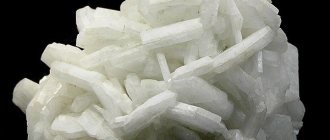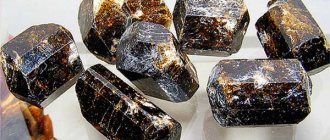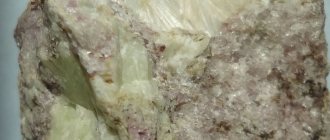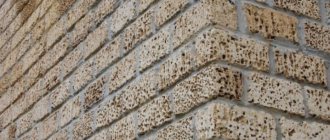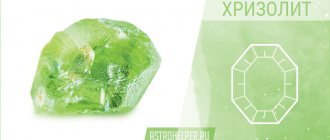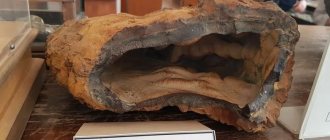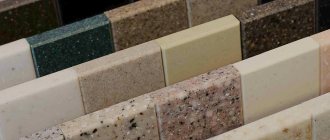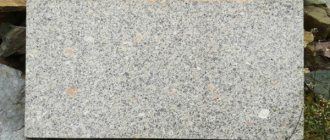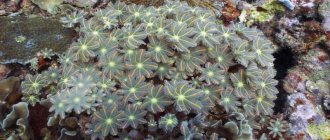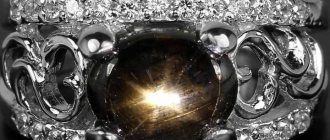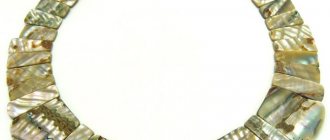In 1963, a book by Soviet science fiction writers E. Voiskunsky and I. Lukodyanov entitled “The Black Pillar” was published. This story tells about geologists and drillers who drilled a well about 50 km deep. But what happened next became the main theme in the narration of the fantastic adventures of the book’s heroes. A substance of unknown origin was squeezed out of the well under the strong pressure of the internal forces of the planet, which encircled our Earth in the form of a black column. But what if you really drill such a well? Will fantasy become reality? And what is this black substance?
Of course, you can immediately answer these questions with one answer - it is impossible to drill a well of such depth due to the lack of technologies and materials for such drilling among humanity. Perhaps the writers had in mind one of the rocks that makes up our lower part of the earth's crust. This is the so-called “basalt layer”, which does not reach the surface anywhere on land and not a single well has reached it. This layer was named due to the similarity of the physical properties of the host rocks with the known properties of basalts. What kind of breed is this? Maybe she, being in a liquid state, broke out under enormous pressure? How does humanity use it in its solid state? Let's try to find answers to all these questions.
What is a stone? Its origin in geology
Basalt is the main cenotype rock, erupted lava.
The earth's crust of our planet, in comparison with other constituent layers (upper and lower mantle, core) is a thin layer in cross-section. It includes “granite” and “basalt” layers, while the basalt layer borders the upper mantle. This boundary in geology is called the Moho boundary, after the name of the Croatian scientist Mohorovicic. In different places on Earth, this boundary is in the depth range from 10 to 90 km, so humanity has not discovered it with wells due to lack of technology. It contains plagioclase, pyroxene, glasses of volcanic origin, olivine and many other minerals. Basalts are sometimes called an effusive analogue of gabbro. The structure is aetheric, with a massive texture, sometimes porous. Often there are basalts interspersed with tonsils, which are filled with quartz, calcite, and chalcedony. This type of basalt is called mandelstein. Based on the size of the grains, they are divided into coarse-grained (dolerites), fine-grained (anamesites) and fine-grained basalts themselves.
Since the formation of basalt is associated with lava flows as a result of geological activity, columnar units are found when they reach the surface. Many people are familiar with such basalt columns from photographs.
These columnar formations are caused by uneven cooling of molten rock. Marine basalts appear in a kind of pillow formation, formed due to the sharp cooling of the lava flow. The incoming lava then breaks through the hardened crust. Protruding from under it, it forms a stone pillow.
The chemical composition of the rock depends on these same conditions for smelting the hot rock, various conditions of interaction with the environment (water, air) during the release of lava and other melting mechanisms.
Basalt stone in construction
Due to its composition and structure, basalt is a hard and viscous rock. Moreover, it is widespread. This made it suitable for construction purposes. In particular, in the production of crushed stone. The stone itself can also be used as a finishing material, but it is actually difficult to find it on sale in such quality. After all, stones are not sold by geologists by training, and in many places there are gross mistakes in stone identification.
In addition, basalt found wide application as a thermal insulation material when the technology for producing basalt wool appeared. Currently, technology has improved significantly, which has made it possible to produce not only cotton wool, but also threads and fabrics from this stone.
In general, other articles on this site are devoted to the use of basalt, so here we will briefly talk about a couple of forms that interested our readers more than others.
Cardboard
Basalt cardboard is a successful marketing ploy for heat insulator manufacturers. Because this thing can only be called “cardboard” in comparison with “cotton wool”. What's the point? The basalt fabric was not left fluffy, but compacted, and then either secured with stitching or bentonite clay. Both are fireproof. The output is a thin mat.
Sheets of basalt cardboard. Photo Teplokontakt
It should be assumed that basalt board was created to fill the market niche of asbestos board, because asbestos is harmful to health. That is, of course, it can be used both as insulation and as a sound insulator, but in this regard you can find more effective things, but as an insulator of very heated objects it is very good.
If you are interested in learning more about basalt cardboard, take a look here.
Plate
It is curious that the term “basalt slab” is now understood not only as a stone slab cut from some block, but also as one of the varieties of products produced by factories that produce... basalt wool. So try to figure out what exactly interests the reader.
As for basalt slabs in the literal sense, we strongly doubt that they are widespread. Still, the presence of volcanic glass in the composition of the stone makes it inferior in quality to deeper analogues , where the same composition formed crystals - we mean gabbro, a stone that is often found in ritual monuments, and in decoration, and in construction.
Basalt wool in the form of a slab. Photo by Leroy Merlin
Fiber slabs made of basalt received this name because of their high density and therefore high weight. A cubic meter of such material can weigh 250 kg. These are rigid thermal insulation materials that are used, for example, in insulating flat roofs, because they do not shrink under the load of a concrete screed.
Basalt slabs are discussed in detail in this article.
Place of Birth
Basalt is a product of solidification of magma rising upward from the depths along tectonic faults and volcanic craters, therefore basalt deposits in its outcrops are found with different types of surfaces of the rock itself. This circumstance is due to the interaction of flowing lava under different conditions (pressure, temperature, etc.) with other rocks and minerals. For example, a bubbly surface is formed during the cooling process of lava, when steam and gases break through the solidified layer, and the voids inside the hot rock are filled with copper, calcium or zeolite.
There are huge deposits of frozen lava flows in the world, for example, in the western part of India (Deccan Plateau), in the USA and in Ukraine. The dormant volcanoes Vesuvius and Etna in Italy are also rich in this rock. In our country, deposits are known in Kamchatka near volcanoes, but they are not sufficiently developed. In Europe, the most famous places where basalt is mined are found in Ireland, Iceland and Scotland.
Appearance of the breed
The stone looks like a dark-colored stone (light-colored specimens are less common). In nature, it is represented by columnar elements in the form of pillars with 3-7 edges. The stones have a porous, dense, massive or almond-shaped structure. In the latter case, the rock is called Mandelstein, the tonsils of which can be filled with calcite, plagioclase and other substances. Depending on the type, basalt is painted in oily shades of black, gray, smoky, greenish-gray (see photo). The presence of yellowish olivine phenocrysts is possible. The edges of the stone are uneven, the surface is rough.
Types of basalt
In colloquial slang, it would be incorrect, from a scientific point of view, to divide basalts into varieties. Therefore, the classification of basalts is divided according to various criteria. Varieties can be distinguished according to the composition of the minerals:
– apatite;
– graphite;
– magnetite;
– labradorite;
– anorthite.
This is what the classification of basalt by chemical composition looks like
| Norit | Picrobasalt | Plagiobasalt | Basalt | Gabbro | Anorthosite | |
| Fe2O3 | 0,5–3 | 3–7 | 3–6 | 2–5 | 0,3–10 | 0,1–1,6 |
| FeO | 4–15 | 7–10 | 4–8 | 6–10 | 1–15 | 0,3–4 |
| MgO | 4–12 | 12–24 | 3–6 | 5–7 | 3–15 | 0,1–3 |
| CaO | 6–12 | 6–9 | 6–12 | 6–12 | 8–18 | 9–14 |
| Na2O | 0,5–3 | 0,5–1,5 | 1,5–3,5 | 1,5–3 | 0,5–3,5 | 1–5 |
| K2O | 0,2–1,5 | 0,1–0,5 | 0,5–1 | 0,1–1 | 0,1–2 | 0,1–1,5 |
| SiO2 | 46–53 | 42–46 | 46–52 | 47–52 | 43–52 | 48–54 |
| TiO2 | 0,2–2 | 0,5–2,5 | 0,5–1,5 | 1–2,5 | 0,1–4 | 0,1–0,7 |
| Al2O3 | 10–21 | 6–12 | 16–20 | 14–18 | 8–27 | 25–32 |
Without going into the geological jungle, we will only note that there are petrochemical (based on the chemical composition of the host minerals, recalculated by the CIPW method), geodynamic and other classifications.
Basalt is the most common effusive rock not only on Earth, but also on other planets, so scientists have decided to divide it according to different criteria.
Therefore, we will derive our own understandable classification of the features of basalt, which will depend on the place of extraction and processing for subsequent use.
Thus, in Asia, dark gray basalt of an asphalt hue is mined. It is used in the decoration of external facades. Moorish basalt is valued for its decorative value due to its dark green color with gold and white inclusions. But its sensitivity to temperature changes should be taken into account and used for finishing interiors. But in China they mine black or “twilight” basalt, which has almost no inclusions of light colors. Well, and many other species, images of which can be found on the vast world wide web.
Meaning and description of rock
Basalt is a stone consisting of igneous rocks. Translated from Ethiopian, its name means “boiling” or “iron-containing”. This name is given to the mineral due to the method of formation. The largest deposits of stone are volcanoes located in all parts of the world.
The stone has high strength. This allows it to be used in various fields, including house construction.
In addition to outstanding physical characteristics, it has a number of healing and magical properties. However, its use is more common in construction and finishing works.
Varieties
The mineral of dark shades is more common. This is due to the presence of volcanic lava in the composition. Black basalt is actively used as a substrate for aquariums. It has high ductility and strength. This distinguishes basalt from granite, which is also used for these purposes.
Gray basalt and stones with a greenish tint are occasionally found.
They are used for the production of insulating materials, facing slabs, and concrete filler.
The appearance depends on the composition of the mineral and the structure of the crystal lattice.
There are:
- glandular;
- ferrobasalt;
- calcareous;
- alkali-calcareous stones.
In the mid-20th century, Yoder and Tilly introduced a classification of minerals based on the chemical composition of the ore.
Highlight:
- quartz-standard (silica predominates);
- nepheline-standard (low silica content);
- hypersthene-normative (quartz or nepheline content is insufficient).
Classifications of minerals are considered conditional, since the chemical composition and origin do not have a significant impact on the qualities and properties of basalt.
To watch a video review about the stone:
What is the difference between granite and basalt?
Granite and basalt are rocks of the same origin, formed as a result of volcanic activity. Composition: silicate minerals containing oxygen and silicon. There are a number of differences between different approaches. Thus, granites are often red with a black tint, and basalt is dark gray, sometimes smoky.
The origin of granite is due to the effects of high pressure and temperature in the depths of the earth's interior. It consists of feldspar, mica and quartz. Color dependence is due to the influence of minerals and impurities. The most durable granites are syenites and labradorites. This rock can withstand temperatures up to 650°C and does not crack, which is comparable to steel.
Basalt is much stronger than granite and is a leader among its own kind. Thus, the compressive strength of granite is 1200-3000 kg/cm, and the density is about 2700 kg/m3, while for basalt these indicators are higher, in particular, the density is 3300 kg/m3.
Another distinguishing feature is the post-processing. Granite is easier to grind and can produce different textures and surface roughness. Therefore, it is widely used in exterior decoration in construction.
Basalt is the heaviest and strongest of volcanic rocks, so certain difficulties arise when processing the stone, but its durability compared to granite justifies this difficulty. Basalt paving stones withstand intense rainfall, chemical and physical influences, as well as temperature changes. Therefore, among the majority of ancient monuments that have survived to our time in relative safety, they are made of basalt. Thus, when choosing between granite and basalt, we can definitely say that basalt is a stronger and more resistant material.
How to spot a fake
Basalt is very similar to granite, but you can tell them apart by their color and porous surface.
The price of minerals depends on the weight and type of processing.
- The price of paving slabs is 1700-2200 rubles per square meter.
- The cost of crushed stone is 500-800 rubles per cubic meter.
- The price of mineral wool is 500-1100 rubles per package.
- Jewelry made from volcanic stone costs from 300 to 1200 rubles.
Basalt is a mineral that is often used in residential construction. This is due to the ease of extraction and its valuable physical and chemical properties. In addition, the mineral has a pleasant appearance and is effective in promoting health. This explains its popularity in various fields.
Physico-chemical characteristics
The physical properties of basalt are varied, as are similar rocks.
Density from 2500 to 3300 kg/m3. Coef. porosity depends on the method of rock formation and is 0.5-19% with water absorption rates of the order of 0.15-10%. Abrasion 2-20 kg/m2. The average melting point is 1150-1260 with a limit of up to 1500 °C. Hardness on the Mohs scale 5-7.
Chemical composition
The chemical composition of basalt varieties by host compounds can be seen in the table above. It should be noted that the main component is silicon dioxide or silica (44-54%). Basalts saturated with silica have an insignificant content of olivine and, conversely, unsaturated SiO2 contain more olivine.
Thermal insulation and sound insulation
Basalt insulation or stone wool is one of the types of mineral wool. It surpasses many similar insulation materials in strength characteristics and is safe for humans and the environment. When compared with mineral wool made from waste and slag from metallurgical production, this insulation is more durable, environmentally friendly and has less water absorption, which makes it an excellent heat insulator. The thermal conductivity coefficient corresponds to foam rubber. The fibers are directed in different directions, which makes it airy and light.
Thus, experience has shown that the ability to retain heat with such insulation 10 cm thick corresponds to the same characteristics for a ceramic brick wall 117 cm thick, a clay wall 160 cm thick, a sand-lime brick wall 200 cm thick or a wooden wall 26 cm thick.
Vapor permeability, hydrophobic properties
It has excellent vapor permeability, and moisture penetrating through the insulation does not form condensation. Basalt wool does not get wet, thanks to special impregnation and the very water absorption properties of basalt fibers, so materials made from such fibers are excellent for the construction of baths and saunas.
Non-flammability, fire safety
Basalt fiber wool, in accordance with the requirements of firefighters, is considered a non-flammable material. The temperature that basalt material can withstand does not reach the melting point of 1114 degrees, which allows it to be used to insulate devices and mechanisms, protecting them from high temperatures.
Description of diagnostic signs
Diagnostic features of basalt may be of interest either to geologists or to hobbyists who collect and identify rocks. Let us say to the last that macroscopic studies require the presence of already defined samples for comparison . There is also a certain sequence in which this research occurs.
External signs of rock
Let's look at the external features of the basalt rock. First, break off a piece from an existing piece of rock, because the chip must be fresh.
Then follow the sequence:
- hardness;
- shine;
- cleavage;
- break;
- color in piece;
- trait;
- other properties.
Hardness
Measured on the Mohs scale , this requires standards of this scale, with which you need to try to scratch the sample. If a scratch can be left, the hardness is considered to be less than that of the standard, most likely in the interval between it and the standard that does not leave a mark on the sample.
If you presumably have basalt, then its hardness depends on the minerals composing it, and they, in turn, have a hardness from 5 to 7. If we take it quantitatively, then hard minerals predominate in basalt, so its hardness is in the range of 6-7 .
If there are no Mohs scale standards, you can use window glass with a hardness of 5.5, as well as a steel knife or steel needle with a hardness in the range of 6-7. Basalt can be difficult to scratch with a steel needle.
Does basalt have shine?
Before answering the question of whether basalt has shine, let’s figure out what is meant by this feature.
Gloss is the ability of a surface to refract and reflect incident light. Geologists distinguish several specific lusters, perceived by analogy with the luster of known substances: metallic, non-metallic, matte, greasy, pearlescent, glassy, silky, waxy. You can remember the image by its name.
As for basalt, some of its phenocrysts have a shine - this is the glassy shine of olivine crystals or pyroxenites, for example. If the structure is not porphyritic, but cryptocrystalline, the glassy sheen of the basalt’s constituent minerals can also be seen on the chip.
Cleavage
The crystal lattice of minerals at the micro level determines the greater or less ease of splitting of the mineral along certain planes at the macro level. There are several types of cleavage: very perfect, perfect, average and imperfect .
Crushed basalt for baths and saunas. Photo Teplokontakt
However, basalt is predominantly non-crystallized or has a cryptocrystalline structure. Therefore, its cleavage is most likely not considered , unless we are talking about large phenocrysts, but these are minerals that are considered separately.
Basalt fracture
The fracture of a rock or mineral can be: earthy, conchoidal, granular, splintered, uneven and stepped.
Fracture of basalt is granular or uneven. In general, it depends on the structure and texture of the sample. For example, it may have conchoidal fracture due to the predominance of volcanic glass.
Color per piece
The color of basalt can vary from black to dark green.
Udeco soil for the River Dark aquarium with a mixed mineral composition: granite, basalt, dark matte marble and others. Photo ZooNemo
Trait
The line is checked by passing a sample over a plate of porcelain without a glaze coating. In basalt, the line matches the color of the sample .
Structure: what is the texture and structure of basalt
A description of basalt would not be complete without a description of the texture and structure of basalt.
Recall that in geology, structure is the structure or composition of a mineral or rock. Categorization can be made in three ways: the degree of crystallization of minerals, by the size of the crystals or grains of the main minerals of a given rock, and also by the form that these crystals or grains take.
Crushed basalt for baths and saunas (fraction 60-150 mm). Photo Teplokontakt
The structure of basalt depends on the rate and conditions of lava cooling. If lava hardens quickly, then crystals do not form; instead, volcanic glass is obtained, and the structure is called aphyric.
If there is a little more time for hardening, grains of minerals are formed. They can be very small, indistinguishable to the eye, then the structure will be granular or cryptocrystalline. If there was enough time for hardening, then the resulting phenocrysts can reach significant sizes; the structure of such basalt will be called porphyritic.
As for texture, this term is understood as a derivative of structure: the relative arrangement in the mass of the constituent parts of the rock. Many basalt samples can have a common massive texture.
The large amount of gaseous fluids in the lava causes gas bubbles to remain in the solidifying lava, and the texture in this case becomes porous or even bubbly. There are samples with a slag-like texture.
In addition, it happens that gaseous fluids form bubbles inside the basalt, in which late minerals are later formed, such basalt is called “Mendelstein” or “almond stone”. The minerals in it are agate, opal, chalcedony, quartz, carnelian, etc.
Separateness
Separateness is an important feature for identifying a rock, but it is nevertheless included among the features associated with its structure. Let us recall that separation is the form that a rock acquires in nature during spontaneous, natural splitting.
In the case of basalt, this may be the first recognizable sign, easily remembered, because it usually looks very impressive. We are referring to the hexagonal pillars that can be observed in a geological basalt outcrop.
It is not a fact that separateness can be discerned in the existing sample.
Is it a pure substance or mixture: what does basalt consist of?
As far as we remember chemistry, a “simple substance” is a substance consisting of atoms of only one element. A “mixture” is a mechanical or homogeneous combination of several substances. Therefore, we are partly perplexed by the question: “is basalt a pure substance or a mixture?”
Let's start with the fact that basalt is definitely not a pure substance , because it does not consist of atoms of one element. Chemically, it is a combination of a dozen oxides.
a mixture either, unless you assume that the solution is a homogeneous mixture. So, once upon a time basalt was a melt in which various substances were mixed, as already mentioned - various oxides. Then this melt solidified, and the conditions of its solidification greatly affected the form in which its constituent components crystallized or did not crystallize.
Let us recall: if the solidification was rapid, then the mass remained as amorphous as it was in the melt. If it slowed down, then some minerals managed to acquire the form of crystals and became phenocrysts. Therefore, what basalt is made of depends on the conditions of its formation .
In general, the chemical composition of basalt can be represented by the following table:
| Oxide | Content, % |
| SiO2 | 47—52 |
| TiO2 | 1—2,5 |
| Al2O3 | 14—18 |
| Fe2O3 | 2—5 |
| FeO | 6—10 |
| MnO | 0,1—0,2 |
| MgO | 5—7 |
| CaO | 6—12 |
| Na2O | 1,5—3 |
| K2O | 0,1—1,5 |
| P2O5 | 0,2—0,5 |
(table taken from Wikipedia)
Regarding its mineral composition , we can say that basalt consists of olivine, plagioclase and augite. It may contain magnetite crystals. If there are visible phenocrysts in the sample, they are usually black pyroxene and dark green olivine.
Also listed above are late minerals that can form within gas voids in the amygdaloid variety of basalt.
It is worth mentioning that over time and under the influence of aqueous solutions, basalt stone undergoes greenstone replacement , as a result of which olivine is replaced by serpentine, and plagioclase by sericite.
Scope of stone application
The area of use of products made from basalt fibers is related to their properties. It is used as an additional component to increase the strength of concrete. Crushed basalt is widely used as a filler for gravel backfilling and the production of asphalt mixtures when laying road surfaces. Insulation of premises, interior decoration and other areas - all this often cannot be done without basalt. However, stone has become the most favorite material among designers, as it is an excellent solution for decorating fireplaces, bar counters, and furniture.
Thanks to noise-absorbing properties, vapor permeability, temperature resistance, environmental friendliness, fire safety and service life, materials made from basalt fiber compare favorably with similar products.
Construction
Recently, basalt paving stones have become widely used. Due to its resistance to environmental chemicals and strength characteristics, it is durable against mechanical abrasion. For the same reasons, steps made of basalt are installed in public institutions with a high traffic volume of visitors.
When building baths and saunas, basalt stones become indispensable in stoves of various configurations. They can withstand high temperatures, cool slowly, retain heat for a long time and do not crack when exposed to water.
Basalt-plastic reinforcement has recently become widespread in construction.
Jewelry
Among jewelers, basalt is of particular interest, which they call lava stone. It goes well with natural stones, emphasizing the beauty of the product. “Frozen Lava” has a beautiful inflorescence with agate and red jasper. Wearing jewelry made from frozen, once-hot lava on the hand or body, which was pushed out of its depths by the Earth with gigantic forces, will bring pleasure to the sophisticated connoisseur of this stone.
Decor
In decorative art, as noted above, this stone has found its application in the manufacture of tiles, panels and paving stones. Basalt products perfectly combine a strict official style. Black and dark tones give the interior a unique, impressive image. In addition to aesthetics, the products have an important feature - they are not subject to corrosion, leaching, exposure to chlorine and UV rays, and mold and other microorganisms do not form on them.
Other areas
Today, basalt furniture is in great demand, despite its high cost. Famous brands offer various hanging chairs, chairs, tables and other accessories in the price range from 20 thousand to 200 thousand rubles, and sometimes higher. The high cost is due to the complexity of processing and the exclusivity of interior items, as well as absolute safety for people in terms of the environment.
Warranty periods for furniture manufacturers start from 15 years and above, and such furniture can be left outdoors without fear that it will be damaged.
History and origin of the mineral
The mineral has been known to mankind since ancient times. It was called the "touch" or "iron-containing" stone. Due to its strength and good insulating qualities, it was already actively used as a construction and finishing material.
The mineral is classified as volcanic rock. It is formed when lava flows and hardens. The stone can be found both in the volcanoes themselves and on the ocean floor.
Based on the geological location of the stone, there are:
- mid-ocean ridge minerals;
- basalts of active continental margins and island arcs;
- intraplate rocks (continental or oceanic).
The chemical composition depends on the igneous rocks that were melted. Also, the properties of the stone are determined by the conditions of formation (degree, melting mechanism).
The most popular basalt products
Stone is known as a raw material for the production of insulating and finishing materials. Basalt insulation materials are distinguished by their heat resistance, vapor permeability, and physical stability. Mineral wool perfectly retains heat in a room. The presence of voids of varying sizes provides reliable thermal insulation.
The use of stone in the manufacture of chimneys for fireplaces or stoves is due to its high temperature resistance.
The material prevents heating of surrounding tissues, ensuring high safety of the structure.
Therefore, stone is actively used to insulate chimneys in bathhouses and rooms where temperature conditions play a significant role in safety.
Mineral tiles are used for facade or interior finishing work. It fits into any design, gives the interior a cozy and finished look.
The popularity of the stone is due to its environmental friendliness and safety. Affordable price and wear resistance make the material a favorite among analogues.
In addition, a video blog about the possible uses of the stone:
How to wear and care for basalt products
Jewelry and interior items made of basalt, unlike other natural stones, do not require careful treatment in terms of care. This is one of the advantages of this natural unique product from the bowels of the Earth. It seems that in the process of his education he has already undergone all the tests of fire and water, that, having finally escaped from the bowels of the earth, he intends to bring benefit and joy to people, without demanding anything in return. It’s enough just not to lose it and occasionally polish it, brushing off dust if any appears.
History of basalt
Basalt bracelet
The history of this rock goes back millions of years. The strength characteristics of basalt were appreciated in ancient centuries; in those days it was already used for the construction of dwellings and the manufacture of household items. The chronicles of Pliny the Elder mention that basalt was first discovered in Ethiopia.
Translated from Greek, “basalt” (basanos) means “touchstone”. In Ethiopian, basal means “iron-containing, boiling stone.”
Magic properties
Today there is little information about the magical properties of this black and mysterious stone. There is an assumption about the effect on increasing male energy. The philosophy of ancient China identified basalt as the best building material for building a house. It was believed that it was in such an atmosphere that family quarrels were limited to zero, and the home was filled with goodwill, positivity and well-being.
But still, some sources contain information about the main magical property of the stone - protection from dark forces. After all, it is basalt that, in geological processes, holds back the molten mass inside the Earth, preventing it from coming up and burning everything around. Therefore, among the qualities that this protective amulet gives us, the main ones stand out - perseverance, courage, sometimes even persistence in achieving our plans and goals. By the way, for yoga adherents, basalt is an object of meditation, which says a lot.
Thus, we can derive a universal formula for basalt - if a person wants to gain the boundaries of understanding, clear contours of desires, fill his actions with precise rhythms and gather all the power in the knowledge of his destiny, then you need basalt.
Magic of stone
Pendulum for dowsing made of balalt stone
The basalt rock has long been considered a talisman against dark forces and ill-wishers. It was placed in the house to protect the home from fires, disasters and accidents, and was taken with them on long journeys.
Basalt also has another purpose. It is used to attract good luck and find ways out of difficult situations. The stone promotes the development of the inner world, causes a craving for learning and the discovery of abilities. It gives peace of mind and peace, develops intuition, enlightens thoughts and motivates to work.
Medicinal properties
There are legends about its medicinal properties. Having gained the power of the four elements, this stone is the king among stones. In Eastern medicine, since ancient times, it has been practiced in stone therapy as a hot stone massage. By heating the stones to a temperature of 40-50 degrees, the heat penetrates deep into the body up to 4 cm, which has a beneficial effect on the body during stress and depression. Basalt as a “hot stone” is the complete antipode to the “cold stone” - marble. It is known to be used for osteochondrosis, muscle spasms and kidney pain. In combination with the use of a variety of essential oils, the effectiveness of therapy increases significantly.
Use as massage balls will bring the owner a long-awaited relaxed state after a difficult and stressful day.
Basalt: special properties of stone
Of course, what makes these properties of basalt special is only the fact that they are not the most popular in reference books, but these are still the same physical properties, and, of course, there are areas of application in which they play an important role.
Characteristic separateness
First, humanity encountered in nature some semblance of temple columns that were not the work of human hands, then scientists began searching for the answer to this phenomenon, and now we already know that the characteristic separation of basalt in the form of faceted columns is the result of the stresses in the stone that arise when its cooling.
When a destructive force acts on a stone, cracks appear first of all where the stress is strongest. And it splits along the lines of these tensions. In the case of basalt, beautiful columns are obtained.
Do not think that nature adheres to ideal geometry when creating these columns. Everything varies, including the number of edges. The smallest number of faces for columnar basalt is 3, the maximum is 7. But still, most often you will find columns with 5 and 6 faces.
Columnar separation is not unique to basalts. In addition, under water, basalts have a completely different structure that is not typical for land - spherical or pillow. It occurs when lava flows underwater, first forming balls, which are then flattened into pillows.
And here there is no correct geometry observed. Something similar to balls and pillows is observed, but in general it is just a jumble of rounded shapes, often with an intricate relief on the surface, which is formed from the fact that the cooled surface often breaks under the pressure of liquid lava, and solidifies again, and breaks again.
Basalt pillows on the bottom of the Pacific Ocean (Hawaii). Photo source
Basalt and water
Is basalt, born in the fiery depths, afraid of water? Let's look at its interaction with it from all possible points of view: is basalt waterproof or permeable, does it allow water to pass through strongly or not, does basalt dissolve in water and with what intensity does the dissolution occur... Well, at the same time, let's touch on the frost resistance of basalt, it also depends on water.
Water permeability and intensity of dissolution in water
Does basalt dissolve in water?
Let's start with the fact that almost everything dissolves in water , only over different periods of time. “A drop wears away a stone,” says popular wisdom.
Polished andesitic basalt. Photo Wild stone
Therefore, you should not think that stones are eternal. In nature, water with substances dissolved in it can change the mineral composition of the rocks through which it seeps. There was one stone, there became another. And it happens that it simply washes away soluble minerals, forming cavities of different sizes that can be filled with secondary minerals.
Basalt is composed predominantly of the following minerals: feldspar (plagioclase) and pyroxene (augite). Both are resistant to water and do not interact with it to form new compounds.
We also found data indicating that silicates and aluminosilicates (the minerals mentioned above belong to them) are considered insoluble in water, which means a solubility of less than 0.01 g/l.
From this we conclude that basalt does not dissolve in water.
Whether it allows water to pass through or not, is it waterproof or permeable?
Here it is worth starting with an explanation of what is meant by this or that term. So what is water permeability? It can be reduced to the ability to absorb and pass water through itself. Therefore, water resistance should be called water resistance.
As for the water permeability of basalt, it, as in the case of any other material, is a derivative of its porosity. That is, roughly speaking, if there are pores, capillaries, or any other passages and cavities for water inside the material, then such a material will absorb and pass water through itself. And to a greater extent, the more such opportunities it has.
Basalt itself is very different - there are massive in which there are no pores or bubbles at all. This can be seen in the cut - with the naked eye or even armed with optics. And there are other varieties - with more or less cavities left inside the basalt by gaseous fluids of the lava. In general, of course, they are common, because lavas always contain gaseous fluids.
Strictly speaking, it is not porosity itself that is responsible for the conductivity of water, but the connection of pores with microcracks , which open under pressure and under the influence of high temperature. Consequently, the fracturing of the sample must be taken into account even to a greater extent than its porosity.
Porosity can be measured. There is a formula based on the ratio of the true density to the density of a specific sample, that is, a sample without bubbles is taken, its mass-to-volume ratio is determined, which gives the true density (or it is taken from reference literature). And then the ratio of mass to volume of the sample under study is measured - the air in the pores will reduce it, and the formula will allow you to name the percentage ratio between air and stone.
It is clear that this question does not assume average answers. You need to take it and measure it if the answer is important for something. Otherwise, you should rely on a visual inspection: if both pores and cracks are visible, then the water permeability will take care of itself.
Basalt and frost
Exposure to cold temperatures in itself is not too critical for the stone. Only in combination with water can it become destructive . Why is that?
Because it is the property of water to increase its volume when frozen. And if liquid water penetrates the stone or is already contained in it in an unbound form, then severe frosts will reach it, freeze it, it will expand and form microcracks.
These cracks will not go away, and in the next freeze-thaw cycle the water will become a little larger. And so on until the stone is completely destroyed.
Ice has a volume only 1/10 greater than the original volume of water. But this is more than enough to tear metal, for example, pipes. Stones are also destroyed by ice, only more slowly.
Frost resistance
For building materials, it is customary to calculate the number of cycles that the material can withstand before failure. Since basalt is a building material (among other things), the frost resistance of basalt has also been studied.
But there is data only for crushed stone. It is sold with different grades of frost resistance - from F15 to F400 . As for these numbers, everything is simple: they mean the number of freeze-thaw cycles that this crushed stone will endure.
How can one and the same stone have such a variation? And the point is not only in the stone, but also in the way drilling and blasting operations and the action of the crusher affected it - both increase fracturing, reducing frost resistance.
Is it harmful to health?
Hm, in general, when asking the question whether basalt is harmful to health, it is worth clarifying how it is supposed to influence this health ? That is, a blow to the head with a basalt cobblestone will cause significant harm to health, but if you do not hit anyone with basalt, then it is a completely harmless stone.
Take the same radiation - it is characteristic of rocks that were formed from melts of higher layers of the earth's crust. Basalt was formed somewhere in the mantle region, and it does not contain radioactive elements.
Crushed basalt. Photo Teplokontakt
The mineral and chemical composition of basalt does not contain anything toxic, as well as the minerals that usually accompany it.
Stone dust is always harmful to the lungs, but where can you find such a danger in everyday life? Unless with the gradual destruction of stone wool over time. But they are usually afraid of glass dust from glass wool - it forms much faster and in large quantities, although the cheapness of glass wool sometimes makes us turn a blind eye to this danger.
Conclusion: basalt is practically harmless .
Other
The energy of basalt makes it a powerful stone, activating mental abilities. Pedantry and confidence are the main qualities of the owner of a “lava stone”. As for zodiac signs, it is not suitable for everyone. Virgos, Capricorns and Taurus are prohibited from wearing it; it is believed that for these signs the effect of basalt can lead to mental disorders and isolation. But Aries, Leo and Sagittarius can safely consider the stone theirs. He will smooth out risks, suggest the correct answer to difficult questions, and will not let emotions get the better of you in difficult life situations.
